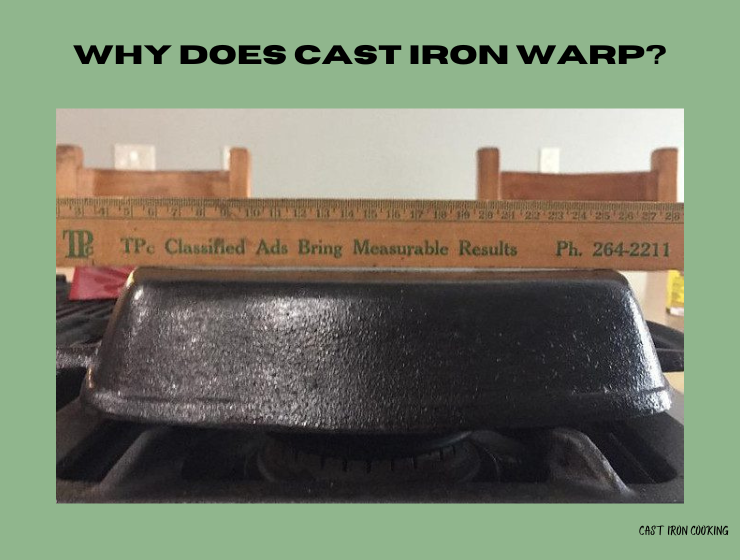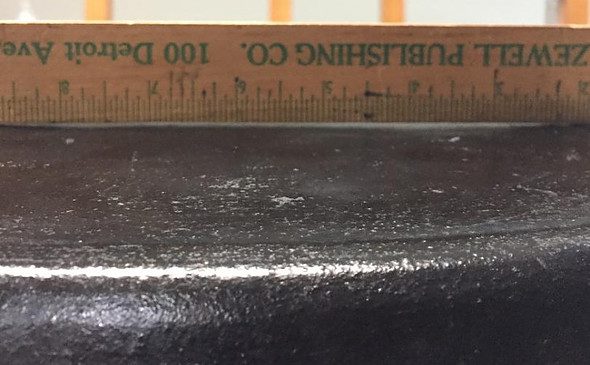Why does cast iron warp?
Warping means distorted in some way, typically through heat or moisture. When cast iron warps, it bows or gets bent out of shape. It can bow up or down, but the result is always an uneven surface.
Maybe you have a warped cast iron pan as I do, and you would like to know why it happened.
Hopefully, If you understand why, you can keep it from happening again.
Warping can range from a slight wobble to spinning when it’s on a flat surface.
Neither is ideal, but spinning is probably the worst.
Let’s look at three reasons cast iron pans can warp and what you can do to keep it from happening.
Table of Contents
Why Does Cast Iron Warp?
When cast iron heats or cools too quickly, it is in danger of warping. For example, when the center of the pan gets hot and the sides stay cool, the hot part of the pan expands. Since the cool part doesn’t expand, it creates stress. And the stress leads to warping. Another way for a cast iron to warp is to put it in cold water while the pan is still hot. When the temperature suddenly changes, it’s called thermal shock. And your pan can warp, crack, or break.
1. Heating the Pan Too Rapidly
When you heat cast iron slowly, the whole pan will heat and expand. But when you heat it too quickly, the center of the pan gets hot and expands while the rest of the pan is still cool to the touch.
The heat is not the problem. Cast iron can withstand very high heat as long as the whole pan is hot. The problem is when only one part of the pan gets hot, and the rest doesn’t.
It has to do with heat conduction and the way it works.
When I first started cooking with cast iron, I didn’t know this could happen. I knew the pan needed to be preheated, but I turned the burner on high without understanding how the metal reacts to heat.
The iron’s surface was heating rapidly, but the sidewalls were not. So the surface expanded, but the sides of the pan didn’t.
You can imagine what would happen. The expanded iron needed someplace to go, but the outer edges and sides were stopping it.
So it did one of the only things it could; it buckled. Or warped.
I’ve also heard stories of a skillet breaking in two or cracking.
However, warping seems to be more common.
Therefore, you should always heat the pan slowly because it has a much better chance of heating evenly and getting the whole pan hot.
RELATED > > > > > Why Does Cast Iron Need to Be Heated Slowly? – 4 Things to Know
2. Thermal Shock
Sudden temperature change leads to thermal shock and is another reason a pan might warp. It can be your pan going from cool to hot too quickly or from hot to cool.
Cooling down your cast iron too quickly is as big an issue as heating it too quickly.
In fact, cooling it down too quickly is often why a pan warps.
When you put a hot pan in cold water, the sudden temperature change is a shock to the iron. It responds in the only way it can; by warping, cracking, or breaking. Again, a pan getting bent out of shape happens more often than the other two.
I didn’t know this could happen, so, as you might guess, I rinsed my pan while it was still hot. And I didn’t think about the temperature of the water.
I may have used hot water because I knew it would do a better job of rinsing off the oil, but I also might have been thinking I wanted to cool the pan down. I rinsed my pan this way day after day until I learned about thermal shock.
And to this day, I still don’t know why my pan warped. Was it from thermal shock, heating it too rapidly, or a combination?
Regardless, a hot pan should only be put under hot water. Cast iron needs to cool down slowly.
RELATED > > > > > Can You Fix a Warped Cast Iron Skillet? – 3 Ways to Try
3. Uneven Heating
I already touched on this, but I want to emphasize that cast iron needs to heat evenly.
That’s why you may have heard that preheating in the oven is the best way.
The oven will indeed heat your pan evenly, but don’t be afraid to heat it on the stovetop.
As long as you understand that you need to heat it slowly, you will be fine. You allow the entire skillet to heat up and expand by heating your pan slowly.
Also, cool it down slowly. You don’t want any sudden temperature changes. Either let the pan cool on the stovetop before rinsing or make sure your water is as hot as possible if you’re going to clean it before it cools down.
My preferred way now is to let it cool naturally, and once I can pick it up with my hands, rinse it in hot water. My way is by no means the only way, though.
Cast iron is very durable, but it does have a few rules.
And as long as you remember to heat it slowly and not put a hot pan in cold water, you should be fine.
Even though I have a warped skillet, it still works well for making our bacon and eggs breakfast.
For a more detailed explanation of why cast iron warps from uneven heating, the following video does a great job of explaining the science of what happens. It specifically targets electric coil stovetops because they are the hardest to regulate with cast iron.
But it can be helpful no matter what you use. I use gas, and I learned quite a few things.
Why Do Cast Iron Skillets Warp On Electric Coil Stovetops?
Final Thoughts
Why does cast iron warp?
It’s pretty simple, and by understanding, you can easily avoid doing the things that cause warpage.
Heat your cast iron pans slowly, so the entire pan gets hot and not just the middle. Since heated iron expands, you want all of the pan expanding and not just part of it.
Also, don’t change the temperature suddenly. This causes a thermal shock, and your pan can warp. Again, it has to do with having two different temperatures simultaneously.
This leads to the final reason, which is uneven heating. Because heat expands, it needs to do so evenly over the entire pan.
As you can see, all three reasons have to do with the pan’s temperature. When the areas of your pan are hot and cold at the same time, you risk it warping.
I have one warped skillet, and that’s because I didn’t understand the reasons why it could happen. All the rest of my cast iron pans are fine.
If you have additional thoughts on why cast iron warps, I would love to hear them. You can let me know in the comment section below.

